E. A. Laboratories
E. A. Laboratories (commonly abbreviated EAL), also E. A. Labs and E. A. Co., was a Brooklyn, NY-based manufacturer of electric appliances intended for vehicular use, founded in 1914 by Emanuel and Michael Aufiero. Despite the challenges E. A. Laboratories faced, it was prominent in the automobile industry and became one of the most successful businesses in Brooklyn in the early-to-mid 20th century.
History
The following information is courtesy of the Brownstoner journal and is partially derived from their work.[1]
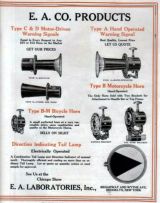
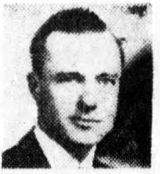
E. A. Laboratories’ story begins in 1882, when Emanuel Aufiero was born in Italy. Along with his brother Michael, they emigrated to America in 1900, seeking better opportunities. Both were mechanically gifted, but Emanuel stood out as an inventive mechanical genius. He had a remarkable ability to understand, use, and improve machinery, making significant contributions to the automotive world. At the dawn of the 20th century, the rapidly evolving automobile industry captured the imagination of many, including the Aufieros. They entered the car accessory business, starting in a small workshop in Manhattan. Emanuel invented the first motor-driven automobile horn, a variation of the classic “ahooga” horn, which became an instant success and marked his entry into auto history.
In 1910, Emanuel had numerous ideas for car horns, windshield wipers, mirrors, signaling lights, and other components that improved driving safety. However, lacking the funds to bring these ideas to fruition, he entered a contract with the Automobile Supply Company of Brooklyn, led by Louis Rubes. This contract allowed Rubes to produce Emanuel's designs but also restricted Emanuel from selling or producing his inventions independently and granted Rubes patent rights to his inventions indefinitely. This restrictive contract put Emanuel in a difficult position, as he had to turn over all his patents to Automobile Supply and was unable to pursue other opportunities. By 1914, feeling stifled by the contract, Emanuel and Michael founded E. A. Laboratories. Michael was the president, and they began producing a new horn that Emanuel had never shown to Rubes.
When Rubes discovered this, he sued, claiming that the horn was Emanuel’s work and thus belonged to Automobile Supply. The lawsuit was extensive, covering 22 patents and generating a 455-page complaint. The case dragged on until 1916. In 1915, Rubes moved his plant to New Jersey due to the litigation, which affected 500 employees. As the trial proceeded in late 1916, Rubes fell ill and had to testify from his home. Despite the lengthy trial, the outcome remains unclear, but by 1917, Rubes filed for bankruptcy, and the Automobile Supply Company was dissolved. With many patents now under his control, Emanuel and his brother continued to grow E. A. Laboratories. The company expanded rapidly, moving to larger premises and eventually building a new factory. The Aufiero family business flourished, producing a range of automobile accessories, including horns, windshield wipers, and signaling devices like sirens, such as the SirEAne, which was first patented around 1921.[2]
Despite his professional success, Emanuel faced personal challenges. The stress of his legal battles and the guilt over the downfall of Automobile Supply took a toll on his mental health, leading to a breakdown and a brief stay in a sanitarium. During his recovery, Emanuel's wife, Adele, took control of his assets, leading to further legal disputes within the family. By the 1940s, E. A. Laboratories was supplying most domestic and international car manufacturers with various products. The company continued to innovate and grow, becoming significant in the automobile accessories market. During World War II, the company shifted to producing war materials, contributing to the war effort by manufacturing gun sights, landing lights, and other military equipment. However, the company faced labor issues and legal challenges during the war. John Aufiero, who had taken over the company, dealt with union strikes and accusations of unpaid overtime. Additionally, John's previous support for Italian fascists came to light, complicating the company's relationship with the government and the union. Despite these challenges, E. A. Laboratories reached an agreement with the union in 1945, allowing the company to resume full production.
Emanuel Aufiero passed away that same year, leaving a legacy of innovation and ingenuity. The company continued to thrive under John Aufiero's leadership, producing a wide range of automobile accessories and maintaining a strong presence in the market. E. A. Laboratories ceased to exist no later than 1954; it is unclear what exactly happened to the company. The company's buildings on Myrtle Avenue are now apartments and offices, with the name "Emanuel Aufiero Building" still visible, honoring the man who invented the musical car horn and whose inventive spirit helped shape one of Brooklyn’s most successful businesses.
Products
SirEAne Jr.
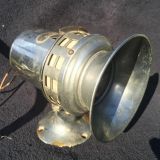
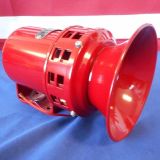

The SirEAne Jr. (a play on words of the company's name), the smaller counterpart of the SirEAne Sr., is a small vehicular directional siren. It consists of a small 8-port rotor and 12-port stator with finger guards on each port to prevent injury from misuse of the siren, as it is small enough to be handheld. The siren is driven by a small 6 or 12 V motor located behind the stator and is housed inside a large cylindrical enclosure. A large, flared horn is bolted to the front of the stator to increase sound output. One unit is known to have an extremely long horn and uses the existing one as an intake; whether or not this was a factory option is unknown. Interestingly, this unit is also marked as a "SirEAne Sr."; this possibly could've been a predecessor to the omnidirectional siren of the same name, as is mentioned in the next section. Some units are also known to have a screen inside of the horn to prevent debris from entering the rotor.
The entire assembly sits upon either a small mount beneath the motor housing or a large pedestal mount, with the former being far more common. At some point in time, the "Jr." was eliminated from the siren's name entirely, evident by some units' tags dropping the name. Although purely speculation, this suggests that the SirEAne Sr. may have been discontinued at some point, leading to the SirEAne Jr. becoming the only siren in the lineup, thus making the "Jr." redundant. The siren measures around 7½" long, 5" wide, and 5½" tall. The siren was rebranded by several different companies throughout its lifespan, with PERKO and Sparton notably offering a rebadged version of the siren under their lineup. In PERKO's case, the siren came standard with the large pedestal mount and came with the option to be primarily constructed out of brass, as PERKO marketed the siren as a maritime signaling device and the standard construction being used on a sea vessel would likely cause the siren to be corroded by the salty air.
SirEAne Sr.
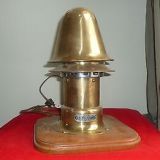
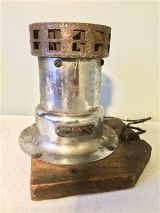
The SirEAne Sr., the larger counterpart of the SirEAne Jr., is a small omnidirectional siren intended for use as a fire alarm. The SirEAne Sr.'s core is relatively similar to its smaller counterpart, consisting of an 8-port rotor and 12-port stator with finger guards on each port to prevent injury from misuse of the siren, as it is small enough to be handheld. The siren is driven by a small 110 V motor located beneath the stator and is housed inside a large cylindrical enclosure, which rests upon a pedestal with 4 holes in each corner, allowing for the siren to be mounted to a flat surface. A small, thin skirt is bolted to the top of the stator to direct the siren's sound downwards, while a large bell-shaped rain shield held up by supports located around the edge of the stator helps protect the siren from the elements. The siren measures around 12⅛" tall and 6¼" wide. The siren was rebranded by several different companies throughout its lifespan, with PERKO and (most likely) Sparton notably offering the siren under their lineup. PERKO's rebrand also came with a brass construction option. Fewer SirEAne Sr. units exist compared to its smaller counterpart, most likely due to the Jr. being cheaper and smaller, while also preforming similarly to the Sr. in terms of sound output.
SirEAne Type 160-A

The Type 160-A, a product of Federal Electric, was also offered under the SirEAne brand for a short time. Whether or not E. A. Laboratories rebranded other Federal sirens is unknown, but it is likely. The siren makes use of a 6-port rotor and stator, with finger guards on each port to prevent injury from misuse of the siren, as it is small enough to be handheld. A screen is also located around the stator for the same reason. The siren is driven by a small 6, 12, or 24 V motor located behind the stator and is housed inside a large bullet-shaped enclosure, which rests upon a pedestal with 2 holes located on each side of its oval shaped base, allowing for the siren to be mounted to a flat surface. A bulbous grille with a V cast on to it is bolted to the front of the stator to prevent debris from running into the rotor; a screen is also located behind it. One of the only known units has its grille flipped on its side; whether this was a standard for SirEAne units is unknown. The siren measures around 5½" tall and 4½" wide.